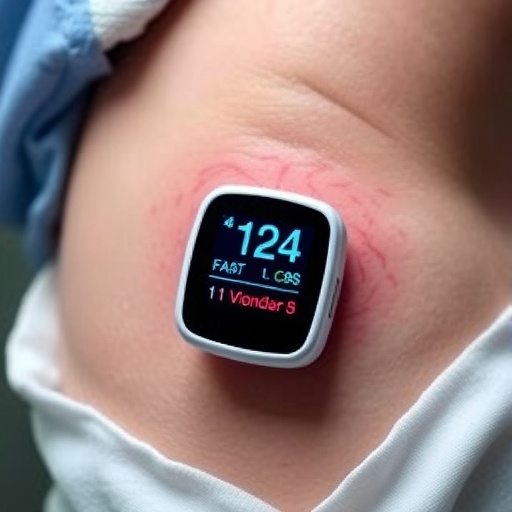Researchers at RMIT University have unveiled a groundbreaking wearable wound monitoring device aimed at transforming the landscape of wound care management. The innovative device is equipped with integrated sensors that promise to significantly reduce infection risks by lowering the frequency of necessary physical contact, thus revolutionizing how healthcare professionals approach wound monitoring. Traditional wound assessment methods often mandate the regular removal of dressings, which can not only prolong the healing process but also impede timely medical interventions. With the advent of this new technology, healthcare providers can now monitor wound healing remotely, leveraging a Bluetooth connection to gather critical data in real-time.
This proof-of-concept device marks a pivotal shift from conventional methods, favoring reuse over disposability and offering a more economical, practical solution compared to smart bandages and emerging technologies in wound monitoring. The research team highlights that millions of individuals globally suffer from chronic wounds, which adversely affect their quality of life while imposing costly burdens on healthcare systems. In Australia alone, approximately 500,000 people are impacted by chronic wounds, which contribute to a staggering $3 billion annual expenditure in healthcare costs.
The lead inventor, Dr. Peter Francis Mathew Elango, emphasized that the device harnesses advanced sensor technology to continuously monitor essential indicators of wound healing. The device incorporates inflammation, pH, and temperature sensors, which collectively provide a comprehensive picture of the healing process. An elevation in temperature may indicate inflammation or even infection, while shifts in pH levels may signify various stages of wound healing. This real-time data empowers healthcare providers to react proactively, mitigating potential complications before they escalate.
.adsslot_CTWYZ1rctp{ width:728px !important; height:90px !important; }
@media (max-width:1199px) { .adsslot_CTWYZ1rctp{ width:468px !important; height:60px !important; } }
@media (max-width:767px) { .adsslot_CTWYZ1rctp{ width:320px !important; height:50px !important; } }
ADVERTISEMENT
In rigorous testing, the team simulated real-world conditions of wound management by affixing the device to a human arm. Notably, the device conformed seamlessly to the arm’s contours, showcasing its potential effectiveness in everyday clinical scenarios. Dr. Elango remarked that this test affirmed the feasibility of alternative remote monitoring technologies, clear evidence of their potential to enhance patient care. With promising results from initial testing, the research team is eager to collaborate with industry partners to develop the device further for clinical trials.
A significant advantage of this innovation lies in its biocompatibility and its integration into existing manufacturing processes, which experts believe could bring production costs down to an impressive $5 per unit when manufactured at scale. The underlying technology is founded on an RMIT-patented platform featuring flexible sensors designed to be placed directly on or near a wound, allowing for continuous, non-invasive monitoring. As such, the device embodies a blend of advanced technology and user-centered design that prioritizes patient comfort and clinical efficacy.
Prof. Madhu Bhaskaran, who leads the research team, elaborated on the technology, noting that high-resistivity silicon-based sensors serve as the core intellectual property of the project. These sensors have been validated in various biomedical applications, demonstrating their efficacy in detecting biomarkers associated with a wide range of health conditions. Prof. Bhaskaran’s research group at RMIT is recognized for its pioneering work in med-tech innovations, including sensor technologies aimed at monitoring sleep quality in aged care facilities.
The implications of this wearable wound monitoring device extend beyond individual patient care. As chronic wound conditions continue to rise globally, this technology has the potential to influence public health strategies by reducing healthcare costs and improving patient outcomes. The researchers are optimistic about the wider application of their technology in outpatient settings or home care, where continuous monitoring can significantly enhance patient management.
Building on earlier successes, Dr. Elango’s previous research on wearable heart monitor technology is also advancing towards commercialization, showcasing the broad potential for wearable health technologies. The team’s latest findings are encapsulated in their journal article entitled “Multiplexed Cutaneous Wound Monitor for Point-of-Care Applications,” slated for publication in Advanced NanoBiomed Research. This article aims to disseminate the knowledge gained from their research, enabling peers to explore the device’s use in their own clinical environments.
As interest in wearable health technology surges, this innovation could inspire future research initiatives aimed at augmenting patient care with intelligent monitoring devices. The wearable wound monitoring device represents a confluence of engineering, material science, and medical innovation, a testament to what the future of healthcare could look like. In an era where technology significantly shapes healthcare delivery, the adoption of such devices could well become a cornerstone of treatment protocols.
The medical community eagerly anticipates further advancements from RMIT University and similar institutions that are dedicated to pioneering innovations in healthcare technology. As clinical trials commence, the true value of the wearable wound-monitoring device will be revealed, having the power to enhance not only individual patient outcomes but also the efficacy of healthcare systems on a broader scale.
Furthermore, the continuous integration of sensor technologies into everyday healthcare could yield invaluable data, fostering a deeper understanding of chronic wound management. Overall, this study reinforces the importance of innovation in the medical field, urging healthcare providers and researchers alike to embrace technological advancements to prepare for the future landscape of health management.
Subject of Research:
Article Title: Multiplexed Cutaneous Wound Monitor for Point-of-Care Applications
News Publication Date: 30-Jul-2025
Web References: RMIT University
References: DOI: 10.1002/anbr.202500142
Image Credits: Will Wright, RMIT University
Keywords
Wearable devices, Biomedical innovation, Wound monitoring technology, Health technology, Chronic wound management.
Tags: Bluetooth-enabled medical deviceschronic wound management solutionscost-effective wound care innovationshealthcare technology advancementsinfection prevention in wound carepatient quality of life improvementsreal-time wound assessment toolsreducing healthcare costs for wound careremote monitoring for chronic woundsRMIT University research breakthroughssensor technology in healthcarewearable wound monitoring technology





